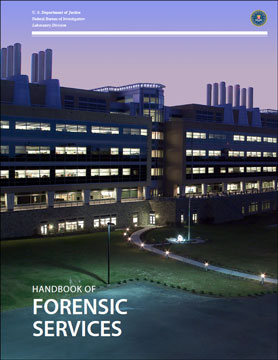|
View in browser: https://www.crime-scene-investigator.net/newsletter/0319.html
|
||
|
MARCH 2019 | ||
| ||
|
This Month's Featured Resource on the Crime Scene Investigator Network Website
|
||
 Handbook of Forensic Services
Federal Bureau of Investigation The Handbook of Forensic Services provides guidance and procedures for safe and efficient methods of collecting, preserving, packaging, and shipping evidence and describes the forensic examinations performed by the FBI's Laboratory Division and Operational Technology Division. The successful investigation and prosecution of crimes require, in most cases, the collection, preservation, and forensic analysis of evidence. Forensic analysis of evidence is often crucial to determinations of guilt or innocence. <View the Publication> |
New CSI and Forensic Job Announcements
|
|
|
The most comprehensive listing of Crime Scene Investigation and Forensic To be notified of job openings as they are posted, follow us on Twitter: Job Posting Alerts |
||
|
Crime Scene Investigator
North Miami Police Department, North Miami, Florida, USA Final Filing Date: May 7, 2019 Performs advanced technical work in the detection, evaluation and preservation of crime scene evidence. Responsible for maintaining the chain of custody for the presentation of collected evidence in court. <View complete job listing> |
||
|
Evidence Officer
Monterey Park Police Department, Monterey Park, California, USA Final Filing Date: Open until filled Performs a wide variety of duties relating to custody, record keeping, control of property and evidence, including video evidence processing and duplication; court liaison duties, assisting investigations personnel with crime scene processing such as latent print collection, crime scene photography, and DNA collection, and other non-hazardous related duties as required. <View complete job listing> |
||
|
Firearms ID Examiner III
Institute of Forensic Sciences, Houston, Texas, USA Final Filing Date: April 21, 2019 Evaluations and test firing of various types of firearms. Performs moderately complex and complex analysis of submitted firearms and firearms related evidence that may include hazardous biological and chemical substances. Performs serial number restorations (firearms). Performs gunshot residue / distance determination examinations. Issues reports accurately reflecting the results of examinations. Provides expert testimony in the discipline of Firearms Identification. <View complete job listing> |
||
 |
||
|
Digital Forensic Analyst
Grand Junction Police Department, Grand Junction, Colorado, USA Final Filing Date: April 12, 2019 Perform forensic computer/digital evidence recovery and analysis on a wide variety of specialized visual and/or computer based related peripheral equipment and data storage devices. Perform a variety of advanced procedures to analyze digital multimedia evidence. Perform advanced analytical procedures to determine authenticity and integrity of evidence and comparative evaluations. <View complete job listing> |
||
|
Forensic Scientist I - Latent Prints
Colorado Department of Public Safety, Bureau of Investigation, Grand Junction, Colorado, USA Final Filing Date: April 19, 2019 Responsible for the preservation, screening/analysis and interpretation of latent print evidence collected in criminal cases for federal, state and local law enforcement agencies. <View complete job listing> |
||
|
Evidence Specialist
King County Sheriff's Office, Seattle, Washington, USA Final Filing Date: March 31, 2019 Responsible for handling Public Safety evidence and property transactions and dispositions. Job duties include the proper disposal and storage of evidence and personal property while adhering to all legal requirements. <View complete job listing> |
||
|
Search for more job listings in Crime Scene Investigations and Forensics To be notified of job openings as they are posted, follow us on Twitter: Job Posting Alerts |
||
|
Other Resources on the Crime Scene Investigator Network Website
|
||
|
Not Subscribed to this Newsletter?
|
||
|
If you are not subscribed to this newsletter, you may subscribe with this link: SUBSCRIBE via email |
||
|
To Unsubscribe
|
||
|
To unsubscribe from future e-mail newsletters, please click here: UNSUBSCRIBE Copyright ©2019 Crime Scene Resources, Inc. Crime Scene Investigator Network |


